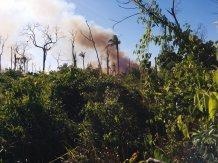May 3 2021
According to a new study, the Brazilian Amazon rainforest discharged more carbon compared to what it stored over the past 10 years, where degradation was a major contributor compared to deforestation.
 Degraded forest in Mato Grosso, Brazil. Image Credit: Ted Feldpausch.
Degraded forest in Mato Grosso, Brazil. Image Credit: Ted Feldpausch.
Over 60% of the Amazon rainforest is found in Brazil, and researchers involved in the new study employed satellite monitoring to quantify carbon storage from 2010 to 2019.
The researchers discovered that degradation (damage to parts of the forest without being destroyed) made up for three times more carbon loss compared to deforestation.
The research group, which includes INRAE, the University of Oklahoma, and the University of Exeter, reported that huge areas of rainforest were destroyed or degraded as a result of climate change and human activity, resulting in carbon loss.
Moreover, the study results reported in the Nature Climate Change journal demonstrate a considerable increase in deforestation in 2019, amounting to 3.9 million hectares compared to around 1 million annually in 2017 and 2018—probably as a result of weakened environmental safety in Brazil.
The Brazilian Amazon as a whole has lost some of its biomass, and therefore released carbon. We all know the importance of Amazon deforestation for global climate change. Yet our study shows how emissions from associated forest degradation processes can be even larger. Degradation is a pervasive threat to future forest integrity and requires urgent research attention.
Stephen Sitch, Professor, Global Systems Institute, University of Exeter
Degradation is associated with deforestation, specifically in a forest’s weakened portions next to deforested zones. However, it also results due to forest fires and tree-felling.
Climate events like droughts tend to increase tree mortality further. This kind of degradation could be difficult to monitor, but the researchers employed the satellite vegetation index L-VOD designed by researchers from CNRS, CEA, and the INRAE.
By employing this index and a new method for tracking deforestation that has been developed by the University of Oklahoma, the researchers assessed variations in forest carbon stocks.
A sharp decrease in the country’s environmental safety was brought about by a change of government in Brazil in 2019.
The 3.9 million hectares of deforestation carried out in 2019 is 30% more than that in 2015, when extreme El Niño droughts resulted in wildfires and elevated tree mortality. But the study illustrates that carbon losses in 2015 were greater compared to 2019.
This illustrates the potential drastic effect of degradation on total biomass and carbon storage in the rainforest.
Journal Reference:
Qin, Y., et al. (2021) Carbon loss from forest degradation exceeds that from deforestation in the Brazilian Amazon. Nature Climate Change. doi.org/10.1038/s41558-021-01026-5.